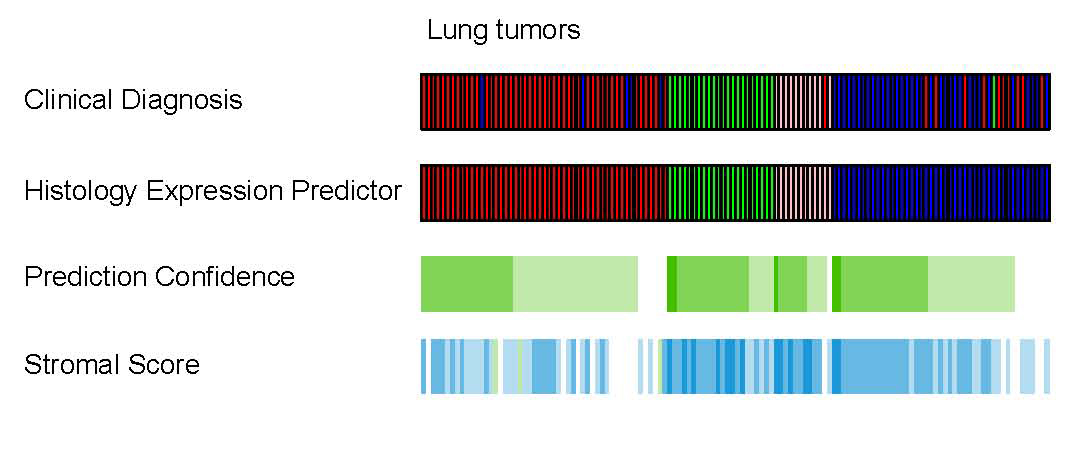Knowing what type of lung cancer a patient has is critical to determine which drug will work best and which therapies are safest in the era of personalized medicine. Key to making that judgment is an adequate tumor specimen for the pathologist to determine the tumor’s histology, a molecular description of a tumor based on the appearance of cells under a microscope. But not all specimens are perfect, and are sometimes so complex that a definitive diagnosis presents a challenge.
Scientists at the Universities of North Carolina and Utah have developed a histology expression predictor for the most common types of lung cancer: adenocarcinoma, carcinoid, small cell carcinoma and squamous cell carcinoma. This predictor can confirm histologic diagnosis in routinely collected paraffin samples of patients’ tumors and can complement and corroborate pathologists’ findings.
Their findings were reported in the July 2013 issue of the Journal of Molecular Diagnostics.

Neil Hayes, MD, MPH, associate professor of medicine and corresponding author of the study says, “As we learn more about the genetics of lung cancer, we can use that understanding to tailor therapies to the individual’s tumor. Gene expression profiling has great potential for improving the accuracy of the histologic diagnosis. Historically, gene expression analysis has required fresh tumor tissue that is usually not possible in routine clinical care. We desperately needed to extend the analysis of genes (aka RNA) to paraffin samples that are routinely generated in clinical care, rather than fresh frozen tissue. That is the major accomplishment of the current study and one of the first large scale endeavors in lung cancer to show this is possible. .
“Our predictor identifies the major histologic types of lung cancer in paraffin-embedded tissue specimens which is immediately useful in confirming the histologic diagnosis in difficult tissue biopsy specimens.” Dr. Hayes is a member of UNC Lineberger Comprehensive Cancer Center.
The scientists used 442 samples of formalin-fixed paraffin-embedded specimens from lung cancer patients at UNC and the University of Utah Health Sciences Center as they developed their predictor.
First author Matthew Wilkerson, PhD, explains, “Our question was, ‘Can histology be predicted accurately by gene expression?’ We had lung cancer genes we already knew were differentially expressed in the different tumor types, so we measured them in tumor paraffin specimens. Next we developed a predictor in an independent set of tumor samples. We then compared the predictor to the actual clinical diagnosis and had additional pathologists review the samples. We showed accuracy as least as good as the pathologist. Our predictor exhibited a mean accuracy of 84 percent, and when compared with pathologist diagnoses, yielded similar accuracy and precision as the pathologists.”
Dr. Hayes summarizes, “Going beyond meeting a current need of increasing the accuracy of histologic diagnosis is expected to be the ultimate benefit of this technology. There are many additional characteristics of tumors that could be leveraged for clinical purposes once the world of gene expression analysis from paraffin is efficient from clinical samples. We anticipate additional uses such as predicting responses to additional therapies and prognostication as near term additions.”
UNC authors are first author Matthew Wilkerson, Patrick Roberts, Xiaoying Yin, Ryan Miller, Leigh Thorne, Kenneth Muldrew, William Funkhouser, Cheng, Fan, Michele Hayward, and Charles Perou.
Other authors are with the University of Utah Health Sciences Center and its Huntsman Cancer Institute and ARUP Institute for Clinical and Experimental Pathology in Salt Lake City, Utah. Senior author is Huntsman Cancer Institute scientist Phillip Bernard.
The research was supported by a Ruth Kirschstein National Research Service Award Individual fellowship from the National Cancer Institute (NIH F32CA142039) and by the Thomas G. Labreque Foundation through Joan’s Legacy Foundation.
Drs. Perou, Hayes and Bernard have a provisional patent related to work described in this study. Drs. Perou and Hayes have stock ownership in and Dr. Hayes serves in an advisory board position for GeneCentric Diagnostics, the company that licensed the patent. Dr. Wilkerson was a consultant for GeneCentric Diagnostics.
Date: July 16, 2013
